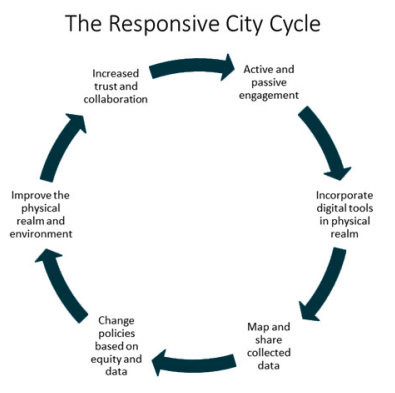From Communications to Engagement – The Responsive City
.png)
Zencity
The Platform for Community Trust
In their paper, “The Responsive City Cycle,” Stephen Goldsmith and Betsy Gardner present a model of trust-building between local governments and their residents based on responsiveness. With the influx of billions of dollars in federal funding through the American Rescue Plan Act and the Bipartisan Infrastructure Law, never before have cities had a better opportunity to meaningfully engage residents around spending, repair, and construction decisions and gain back trust through the “loop of responsiveness,” presented in the paper.
One question we hear time and again from our partner communities is when and how to respond to resident concerns and feedback. Embedded in this question is a growing understanding that responsiveness is a crucial component of resident engagement.

Gone are the days when local governments could get away with simply sending out information and calling it a day. Residents are interested in dialogue with their local government leaders; they demand an active role in shaping their communities rather than being silent recipients of programs and services. In turn, local government leaders are increasingly interested in developing more robust, effective, and holistic engagement with residents.
Local governments are moving away from informing and towards engaging residents. This means that city channels and tools need to be more than bulletin boards but active platforms of dialogue that allow for and support the many pillars of resident engagement: providing information, soliciting feedback, analyzing feedback and sharing results, acknowledging and responding to concerns as they emerge in real-time, collaborating with residents, and reporting on progress.
Responsiveness is the foundation for trust between residents and local governments: “The building blocks require enhancements in how leaders listen to and engage with residents—and which in turn help them prioritize equity, address areas of neglect, open new avenues of communication, and, as a result, enhance trust.”
Technology and digital tools are key for the responsive city: “Equity requires that city hall listens to those whose views are insufficiently represented in calls for action, and that officials listen earlier in the life cycle of an issue. Modern technologies and the almost ubiquitous use of smartphones provide the tools for change. Residents use digital platforms daily in their lives. Government needs to utilize the same approaches to deepen understanding, learn more from more people, create more equitable sources of information, and produce a higher caliber of community services.”
%20copy-1.png?width=544&height=120&name=Logo_black%20(1)%20copy-1.png)



